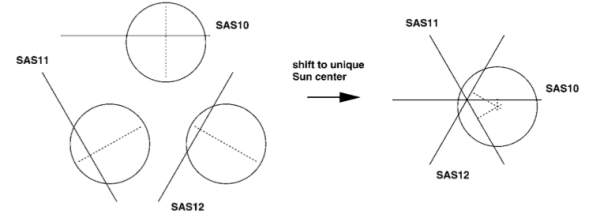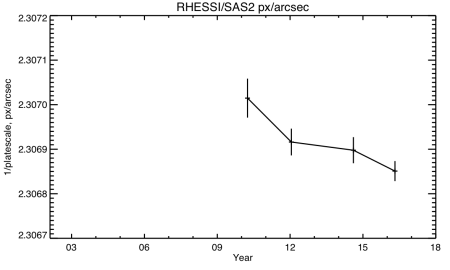The Interesting RHESSI/SAS Archive
| Nugget | |
|---|---|
| Number: | 342 |
| 1st Author: | Hugh Hudson |
| 2nd Author: | Martin Fivian |
| Published: | 7 January 2019 |
| Next Nugget: | RHESSI/SAS archive |
| Previous Nugget: | The flight of FOXSI-3 |
Introduction
To do arc-second imaging spectroscopy, RHESSI needed to have an aspect system with sub-arcsecond precision. The way in which this was accomplished has led to a quite interesting database of a unique sort, as described in this Nugget, generated by the Solar Aspect System (SAS; see Ref. [1]). This database consists of a very large number of 1D images of chords across the nearly circular solar image, at random orientations. Most of these record just the few pixels at the location of the solar limb, but many cover the full diameter of the Sun. All of them help to define the location of the limb at high temporal and angular resolution. One should note that the solar atmosphere is gaseous, in actuality a plasma with weak ionization but a strong and complicated magnetic field. The measure of fuzziness is the ratio of one gravitational scale height to the mean solar radius, which is of order 0.02% (200 parts per million, ppm). In relative terms this might seem quite sharp, and indeed images of the Sun at visible wavelengths show it to be rather well-defined.
Somewhat confusingly we can measure its location with much greater precision than the scale of the fuzziness, for example by using RHESSI/SAS data.
If it is fuzzy, why do we care about precise measurements? In this Nugget we show that SAS worked very well indeed, and this signals some good news for the stability of RHESSI hard X-ray image quality.
SAS
RHESSI rotates with an approximately 4 sec period, and also nutates somewhat because of stray torques imposed on the spacecraft. SAS consists of simple lenses focused on three linear CCDs whose 1D images almost always cross the disk of the Sun, defining its edge location (the limb). The nutation means that RHESSI wobbles, and the X-ray image (produced by shadow patterns) moves continously around relative to the detector arrays. Figure 1 illustrates the geometry.

The three SAS imagers are very unusual telescopes in that they are rotating continuously around axes that lie close to their optical axes. The linear CCDs have sufficiently fast readout to make this possible, and the resulting image reconstructions do no suffer so strongly from fixed in the optics. Some earlier Nuggets have described simple imaging (with a time resolution of about one month!), a Venus transit, and signatures of faculae. We have also used a small susbset of the data to measure the oblateness of the Sun to high precision (Ref. [2]).
The 16-year database
Data acquistion by RHESSI ended in 2017, and so a complete database now exists. In this Nugget we briefly describe a very simple use of the a subset of these data, the complete 1D images. Figure 2 shows the number of such images acquired per orbit (about 5000 sec) over the full interval.

We have looked quickly at the anneal intervals of dense sampling of SAS data. These conveniently lasted for about one month, but long enough to reveal subtle systematic effects that might compete with the averaging. The results show rather spectacular stability, as displayed in Figure 3.
This stability means that the RHESSI metering tube was not shrinking significantly in the latter half of the mission. This was a known risk because of outgassing in carbon composite materials, but we had already dismissed this risk before launch via a protracted vacuum bakeout of a flight spare. The limit for uncertainty in RHESSI's absolute radial location implied here is better than 0.5 arcsec.
Conclusions
The SAS observations of the location of the visible solar limb show that the RHESSI metering tube nicely met its stability specification over the extended mission. This stable dataset, only a tiny fraction of which was used (and in the simplest kind of analysis) also will have things to say about the structure and variation of the solar limb, as our early oblateness result (Ref. [2]) had already suggested. This work remains to be done, we hope via access to the RHESSI legacy database - too be finalized after the U.S. government shutdown has ended! We hope that any secular change of the solar diameter can be pinned down more accurately than the limit set by the excellent observations of Ref. [3].
References
[1] "RHESSI Aspect Reconstruction"
[2] "Large Excess in Apparent Solar Oblateness Due to Surface Magnetism"
[3] "Accurate Determination of the Solar Photospheric Radius"
